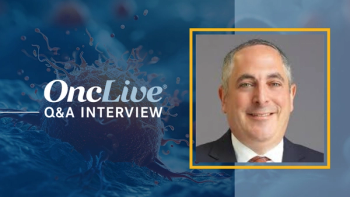
- Vol. 22/No. 06
- Volume 22
- Issue 06
A New Crop of ER-Targeting Agents Takes Root
Although endocrine therapies have revolutionized the treatment of breast cancers driven by the estrogen receptor, the development of resistance remains a major challenge that limits long-term remission with currently available drugs.
Although endocrine therapies have revolutionized the treatment of breast cancers driven by the estrogen receptor (ER), the development of resistance remains a major challenge that limits long-term remission with currently available drugs. Now there is a growing trend toward developing more potent endocrine therapies with the potential to address this challenge.
Data highlighted at conferences in the last year showcased the significant potential of oral selective ER downregulators (SERDs) being developed for heavily pretreated ER-positive breast cancers, including those that harbor ESR1 mutations, a common mechanism of resistance.
Treatment frontrunners include Sanofi’s amcenestrant (SAR439859), Genentech’s giredestrant (GDC-9545), and AstraZeneca’s AZD9833, with all 3 companies betting on their drug’s success in recently initiated phase 3 clinical trials. Meanwhile, other pharmaceutical companies are investing in new drug designs, such as Connecticut-based Arvinas’ first-in-class proteolysis-targeting chimera (PROTAC)based drug, ARV-471 (Table).
Table. ER-Targeting Therapies in Development for ER-positive, HER2-negative Breast Cancer
Standard of Care
Nearly 80% of breast cancers express the ER, making it the most significant driver of this tumor type. In patients with ER-positive breast cancer, endocrine therapy has been the gold standard for decades, beginning with the approval of tamoxifen in the 1970s. Tamoxifen is a selective ER modulator (SERM), a class of agents that act as either ER agonists or antagonists, depending on the tissue. Tamoxifen competes with estrogen for binding to the ER and blocks estrogen-dependent gene transcription and the resulting cellular outcomes.1
Tamoxifen remains a recommended treatment option for patients with ER-positive breast cancer and has been joined by the FDA-approved SERMs toremifene (Fareston) and raloxifene (Evista).2,3 These drugs are often mistakenly referred to as antiestrogens; however, their mechanism of action is much more complex. They can elicit a spectrum of effects, from mimicking estrogen to almost purely antiestrogenic activity.4,5
The mechanisms behind these processes are thought to be related to the SERMs’ interfering with the ER’s ability to recruit coregulatory proteins upon activation. The balance between the activating and repressive coregulatory proteins present within a specific cell may therefore dictate the outcome of SERM activity.4,5
Regardless of the underlying biology, these varying events have important implications. Because of tamoxifen’s estrogenic activity in certain tissues, serious adverse effects (AEs) are associated with the drug’s long-term use.5,6
A number of other endocrine therapies have been developed over the years. SERDs antagonize ER activity in a manner similar to that of SERMs, but they have a much higher binding affinity and also induce ER degradation. SERDs are purely antiestrogenic, with none of the agonist effects of SERMs. Currently, fulvestrant (Faslodex) is the only FDA-approved SERD in the breast cancer setting.5,6
Members of a third class of endocrine therapy, aromatase inhibitors (AIs), act indirectly on the ER signaling pathway by inhibiting the activity of the aromatase enzyme involved in the biosynthesis of estrogens from androgens. AIs, which include the steroidal compound exemestane and the nonsteroidal drugs letrozole and anastrozole are recommended treatment options in the adjuvant setting, either as initial adjuvant therapy or following tamoxifen. In the metastatic setting, they are the recommended firstline treatment, demonstrating advantages over tamoxifen.5-7
The Challenges of Resistance
The benefits of endocrine therapy in ER-positive breast cancer are irrefutable. However, many patients either will have intrinsic resistance or will develop resistance over the course of treatment, which is a major barrier to long-term remission.
A greater understanding of the mechanisms underlying resistance to endocrine therapy has translated into new treatment options designed to tackle resistance. Exploiting cross talk between ER signaling and other intracellular signaling pathways, inhibitors of cyclin-dependent kinases (CDKs) 4/6 and PI3K are now approved by the FDA for the treatment of patients with ER-positive breast cancer.7
These drugs are currently approved for use in combination with endocrine therapy (although abemaciclib [Verzenio] also has a monotherapy indication) in the advanced or metastatic setting. Ongoing clinical trials are looking at such combinations in early-stage breast cancer.
Activating mutations in the ESR1 gene, which encodes the main form of ER in the breast, represent another significant mechanism of resistance to currently available endocrine therapies. De novo ESR1 mutations are found at low frequencies in patients with newly diagnosed disease, but acquired mutations occur in up to 40% of patients who have previously received endocrine therapy.8,9 Most common are the Y537S and D538G point mutations, accounting for 14% and 36% of somatic ESR1 mutations, respectively.10
Although ESR1 mutations promote some level of resistance to all currently available endocrine therapies, fulvestrant appears to be the least affected.11,12 However, its potency is believed to be limited by its intramuscular route of administration, and an oral SERD could prove more effective and less susceptible to endocrine resistance.13
Oral SERDS Hit Their Stride
Initial efforts to develop orally bioavailable fulvestrant-like steroidal SERDs were unsuccessful.13 A growing number of nonsteroidal oral SERDs are in clinical development and have demonstrated promising antitumor activity in patients with advanced ER-positive breast cancer, including those with ESR1 mutations.
Amcenestrant
Sanofi is developing amcenestrant, which has shown early signs of clinical efficacy in the phase 1/2 AMEERA-1 trial (NCT03284957) in postmenopausal women with heavily pretreated ER-positive, HER2-negative advanced or metastatic breast cancer. AMEERA-1 is evaluating amcenestrant as monotherapy and in combination with other anticancer therapies.14
Updated results from the monotherapy cohorts were reported at the 2020 San Antonio Breast Cancer Symposium (SABCS). Pooled data from 62 women included results from those who had received escalating doses from 150 mg to 600 mg once daily in part A (n = 13) and 400 mg once daily during dose expansion (part B; n = 49). All patients had received prior endocrine therapy in the advanced setting, with approximately half having received 3 or more lines.
Among the 59 evaluable patients, the objective response rate (ORR)—all partial responses (PRs)—was 8.5%, and the clinical benefit rate (CBR) was 33.9%. Patients with (n = 30) and without (n = 28) ESR1 mutations derived similar clinical benefit from amcenestrant (CBR, 36.7% vs 32.1%, respectively).
Of note, the ORR and CBR were higher in a subset of patients who had not received prior therapy with CDK4/6 inhibitors, mTOR inhibitors, or fulvestrant compared with the overall cohort of patients who generally had been heavily pretreated (ORR, 21.4% vs 8.5%; CBR, 64.3% vs 33.9%). These findings support the development of amcenestrant as first-line therapy, which is being evaluated in the AMEERA-5 trial (NCT04478266).
Amcenestrant displayed a favorable safety profile, with exclusively grade 1 or 2 treatment-related adverse effects (TRAEs), most commonly hot flush, constipation, arthralgia, decreased appetite, vomiting, diarrhea, nausea, and fatigue. No patients discontinued therapy due to AEs.14
Giredestrant
Initial data from a first-in-human phase 1 trial (NCT03332797) of another oral SERD, giredestrant, were presented at SABCS in 2019. They showed encouraging activity in patients with previously treated advanced breast cancer, including those with ESR1-mutant tumors.15 The recommended phase 2 dose identified in this dose-escalation portion of the trial, 100 mg once daily, was then explored in a dose-expansion phase as monotherapy and in combination with palbociclib (Ibrance) in postmenopausal women. Pre- and perimenopausal patients also received a luteinizing hormonereleasing hormone agonist.
Results from the dose-expansion phase were presented at the 2020 American Society of Clinical Oncology meeting. Eighty-eight patients had been enrolled in 2 cohorts (cohort A, giredestrant monotherapy, n = 40; and cohort B, giredestrant plus palbociclib, n = 48).
The 40 evaluable patients in cohort A had a median progression-free survival (PFS) of 7.8 months (95% CI, 5.3-11.4) and an ORR of 13% (95% CI, 4%-30%).
Giredestrant monotherapy was well tolerated, with mostly grade 1 or 2 TRAEs and no discontinuations. In cohort B, giredestrant demonstrated a median PFS of 9.3 months (95% CI, 8.9-not evaluable) and an ORR of 33% (95% CI, 20%-49%) among 43 evaluable patients.
Most AEs also were of grade 1 or 2 severity in the combination arm, with 1 serious AE of grade 3 QT prolongation in a patient with preexisting coronary artery disease.16
The phase 3 preservERA Breast Cancer trial of giredestrant in combination with palbociclib in patients with metastatic breast cancer is ongoing (NCT04546009).
AZD9833
AstraZeneca’s AZD9833 has also advanced into phase 3 clinical testing. In the phase 1 SERENA-1 trial (NCT03616587), as of August 2020, a total of 146 patients had received AZD9833 either as monotherapy (n = 98) across dose-escalation and expansion cohorts (parts A and B, respectively) or in combination with palbociclib (n = 48; parts C and D).
The median number of prior lines of therapy was 3 for patients in the monotherapy parts and 2 for those treated with combination therapy. The ORR and CBR for monotherapy were 10.0% and 35.3%, respectively, and median PFS was 5.4 months. In CDK inhibitor–naïve patients treated with combination therapy, the ORR and CBR were 14.3% and 71.4%, respectively.
The majority of TRAEs were of grade 1 or 2 severity and most commonly included anemia, fatigue, lymphopenia, nausea, neutropenia, thrombocytopenia, and reduced white blood cell count. The 5 dose-limiting toxicities (3 for monotherapy and 2 for combination therapy) were managed with dose interruption or reduction. There were 2 serious AEs potentially related to AZD9833 in the monotherapy arm. No patients discontinued treatment due to TRAEs.17
A number of clinical trials testing AZD9833 are ongoing, including the phase 3 SERENA-4 trial. In this study, investigators are evaluating the combination of AZD9833 and palbociclib in patients with treatment-naïve advanced or metastatic breast cancer (NCT04711252).
Elacestrant
Other notable SERDs in development include elacestrant (RAD-1901). Findings from a phase 1 study (NCT02338349) showed that elacestrant monotherapy resulted in an ORR of 19.4% among 31 heavily pretreated patients who received the recommended phase 2 dose of 400 mg once daily. No dose-limiting toxicities occurred and the most common AEs were nausea, increased blood triglycerides, and decreased blood phosphorus.18
In September 2020, Radius Health reported that the ongoing phase 3 EMERALD trial (NCT03778931), comparing elacestrant against standard endocrine therapy in patients with previously treated advanced breast cancer, had reached its enrollment goal of 466 patients, including 220 with ESR1 mutations.19
Additional Novel Strategies
Beyond oral SERDs, other novel ER-targeting drug designs have been developed in an effort to overcome endocrine resistance. H3B-6545 is a first-in-class selective ER covalent antagonist (SERCA) being developed by H3 Biomedicines. It binds covalently to a cysteine residue present in both the wild-type and mutant ER and induces an irreversible antagonistic conformation in a manner that is distinct from that of SERMs and SERDs.20
As of February 2020, 130 patients had been enrolled in the dose-escalation (100-600 mg once daily) and dose-expansion (450 mg once daily) parts of an ongoing phase 1/2 clinical trial (NCT03250676) of H3B-6545 in pre- or postmenopausal women with previously treated advanced breast cancer. Fifty-eight percent of patients had ESR1 mutations.
Among 105 evaluable patients, 13 had confirmed PRs, 11 of which were in patients treated with the 450-mg dose. Investigators reported 3 PRs in the 12 patients with the ESR1 Y537S mutation. In addition, H3B-6545 demonstrated a manageable safety profile.21
PROTACs are targeted protein degraders pioneered by Arvinas, a clinical-stage biopharmaceutical company founded by the Yale University investigators who developed the technology.22
ARV-471 is a PROTAC in which estradiol, an estrogen hormone, is linked to a small-molecule ubiquitin E3 ligase–binding moiety. This drug is designed to facilitate an interaction between the ER and an E3 ligase complex that will tag the ER for degradation by the ubiquitin-proteasome system.6,23
In a December 2020 press release, Arvinas detailed interim findings from a phase 1 clinical trial of ARV-471 (NCT04072952). As of November 2020, 21 patients had completed at least 1 treatment cycle. They were heavily pretreated, with a median of 5 prior lines of therapy. The findings included 1 confirmed PR, 2 unconfirmed PRs, and a CBR of 42%. The most common TRAEs were nausea, arthralgia, fatigue, and decreased appetite; all were grade 1 or 2. A cohort expansion in which ARV-471 is administered in combination with palbociclib is ongoing.24
References
- Rondón-Lagos M, Villegas VE, Rangel N, Sánchez MC, Zaphiropoulos PG. Tamoxifen resistance: emerging molecular targets. Int J Mol Sci. 2016;17(8):1357. doi:10.3390/ijms17081357
- NCCN. Clinical Practice Guidelines in Oncology. Breast cancer, version 1.2021. Accessed February 4, 2021. https://www.nccn.org/professionals/physician_gls/pdf/breast.pdf
- Awan A, Esfahani K. Endocrine therapy for breast cancer in the primary care setting. Curr Oncol. 2018;25(4):285-291. doi:10.3747/co.25.4139
- Osborne CK, Zhao H, Fuqua SA. Selective estrogen receptor modulators: structure, function, and clinical use. J Clin Oncol. 2000;18(17):3172-3186. doi:10.1200/JCO.2000.18.17.3172
- Patel HK, Bihani T. Selective estrogen receptor modulators (SERMs) and selective estrogen receptor degraders (SERDs) in cancer treatment. Pharmacol Ther. 2018;186:1-24. doi:10.1016/j.pharmthera.2017.12.012
- Fanning SW, Greene GL. Next-generation ERα inhibitors for endocrine-resistant ER+ breast cancer. Endocrinology. 2019;160(4):759-769. doi:10.1210/en.2018-01095
- Shen L-S, Jin X-Y, Wang XM, Tou LZ, Huang J. Advances in endocrine and targeted therapy for hormone-receptor-positive, human epidermal growth factor receptor 2-negative advanced breast cancer. Chin Med J (Engl). 2020;133(9):1099-1108. doi:10.1097/CM9.0000000000000745
- Jeselsohn R, Yelensky R, Buchwalter G, et al. Emergence of constitutively active estrogen receptor-α mutations in pretreated advanced estrogen receptor-positive breast cancer. Clin Cancer Res. 2014;20(7):1757-1767. doi:10.1158/1078-0432.CCR-13-2332
- Robinson DR, Wu YM, Vats P, et al. Activating ESR1 mutations in hormone-resistant metastatic breast cancer. Nat Genet. 2013;45(12):1446-1451. doi:10.1038/ng.2823
- Toy W, Weir H, Razavi P, et al. Activating ESR1 mutations differentially affect the efficacy of ER antagonists. Cancer Discov. 2016;7(3):277-287. doi:10.1158/2159-8290.cd-15-1523
- Furman C, Hao MH, Prajapati S, et al. Estrogen receptor covalent antagonists: the best is yet to come. Cancer Res. 2019;79(8):1740-1745. doi:10.1158/0008-5472.CAN-18-3634
- Reinert T, Saad ED, Barrios CH, Bines J. Clinical implications of ESR1 mutations in hormone receptor-positive advanced breast cancer. Front Oncol. 2017;7:26. doi:10.3389/fonc.2017.00026
- Shagufta, Ahmad I, Mathew S, Rahman S. Recent progress in selective estrogen receptor downregulators (SERDs) for the treatment of breast cancer. RSC Med Chem. 2020;11(4):438-454. doi:10.1039/C9MD00570F
- Linden HM, Campone M, Bardia A, et al. A phase 1/2 study of amcenestrant (SAR439859), an oral selective estrogen receptor (ER) degrader (SERD), as monotherapy and in combination with other anti-cancer therapies in postmenopausal women with ER-positive (ER+)/human epidermal growth factor receptor 2-negative (HER2-) metastatic breast cancer (mBC): AMEERA-1. Presented at: 2020 San Antonio Breast Cancer Symposium; December 8-11, 2020; virtual. Abstract PD8-08.
- Jhaveri K, Winer EP, Lim E, et al. A first-in-human phase I study to evaluate the oral selective estrogen receptor degrader (SERD), GDC-9545, in postmenopausal women with estrogen receptor-positive (ER+) HER2-negative (HER2-) metastatic breast cancer. Cancer Res. 2020;80(suppl 4):PD7-05. doi:10.1158/1538-7445.SABCS19-PD7-05
- Lim E, Jhaveri KL, Perez-Fidalgo JA, et al. A phase Ib study to evaluate the oral selective estrogen receptor degrader GDC-9545 alone or combined with palbociclib in metastatic ER-positive HER2-negative breast cancer. J Clin Oncol. 2020;38(suppl 15):1023. doi:10.1200/JCO.2020.38.15_suppl.1023
- Baird R, Oliveira M, Ciruelos EM, Patel MR. Updated data from SERENA-1: a phase 1 dose escalation and expansion study of the next generation oral SERD AZD9833 as a monotherapy and in combination with palbociclib, in women with ER-positive, HER2-negative advanced breast cancer. Presented at: 2020 San Antonio Breast Cancer Symposium; December 8-11, 2020; virtual. Abstract PS11-05.
- Bardia A, Kaklamani V, Wilks S, et al. Phase I study of elacestrant (RAD1901), a novel selective estrogen receptor degrader, in ER-positive, HER2-negative advanced breast cancer. J Clin Oncol. Published online January 29, 2021. doi:10.1200/JCO.20.02272
- Radius Health & Menarini Group provide elacestrant update. News release. Radius Health Inc and Menarini Group. September 24, 2020. Accessed February 4, 2021.
https://www.biospace.com/article/radius-health-and-menarini-group-provide-elacestrant-update/ - Puyang X, Furman C, Zheng GZ, et al. Discovery of selective estrogen receptor covalent antagonists for the treatment of ERαWT and ERαMUT breast cancer. Cancer Discov. 2018;8(9):1176-1193. doi:10.1158/2159-8290.CD-17-1229
- Hamilton EP, Wang J, Pluard T, Johnston S, Morikawa A. Phase I/II trial of H3B-6545, a novel selective estrogen receptor covalent antagonist (SERCA), in estrogen receptor positive (ER+), human epidermal growth factor receptor 2 negative (HER2-) advanced breast cancer. Presented at: 2020 San Antonio Breast Cancer Symposium; December 8-11, 2020; virtual. Abstract 1142.
- ARV-471: an ER-targeting protein degrader for breast cancer. Arvinas. Accessed February 4, 2021.
https://www.arvinas.com/pipeline-programs/estrogen-receptor - Gao H, Sun X, Rao Y. PROTAC technology: opportunities and challenges. ACS Med Chem Lett. 2020;11(3):237-240. doi:10.1021/acsmedchemlett.9b00597
- Arvinas releases interim clinical data further demonstrating the powerful potential of PROTAC protein degraders ARV-471 and ARV-110. News release. Arvinas, Inc. December 14, 2020. Accessed February 4, 2021.
https://ir.arvinas.com/news-releases/news-release-details/arvinas-releases-interim-clinical-data-further-demonstrating/
Sidebar References
- Kumar R, Zakharov MN, Khan SH, et al. The dynamic structure of the estrogen receptor. J Amino Acids. 2011;2011:812540. doi:10.4061/2011/812540
- Fanning SW, Greene GL. Next-generation ERα inhibitors for endocrine-resistant ER+ breast cancer. Endocrinology. 2019;160(4):759-769. doi:10.1210/en.2018-01095
- Patel HK, Bihani T. Selective estrogen receptor modulators (SERMs) and selective estrogen receptor degraders (SERDs) in cancer treatment. Pharmacol Ther. 2018;186:1-24. doi:10.1016/j.pharmthera.2017.12.012
- Dhamad AE, Zhou Z, Zhou J, Du Y. Systematic proteomic identification of the heat shock proteins (Hsp) that interact with estrogen receptor alpha (ERα) and biochemical characterization of the ERα-Hsp70 interaction. PLoS One. 2016;11(8):e0160312. doi:10.1371/journal.pone.0160312
- Lipovka Y, Konhilas JP. The complex nature of oestrogen signalling in breast cancer: enemy or ally? Biosci Rep. 2016;36(3):e00352. doi:10.1042/BSR20160017
- Rondón-Lagos M, Villegas VE, Rangel N, Sánchez MC, Zaphiropoulos PG. Tamoxifen resistance: emerging molecular targets. Int J Mol Sci. 2016;17(8):1357. doi:10.3390/ijms17081357
- Jeselsohn R, Yelensky R, Buchwalter G, et al. Emergence of constitutively active estrogen receptor-α mutations in pretreated advanced estrogen receptor-positive breast cancer. Clin Cancer Res. 2014;20(7):1757-1767. doi:10.1158/1078-0432.CCR-13-2332
- Robinson DR, Wu YM, Vats P, et al. Activating ESR1 mutations in hormone-resistant metastatic breast cancer. Nat Genet. 2013;45(12):1446-1451. doi:10.1038/ng.2823
Articles in this issue
almost 5 years ago
Navitoclax Shows Early Signs of Clinical Benefit in Myelofibrosisalmost 5 years ago
Study Tests Guidelines for Monitoring Pancreatic Cystsalmost 5 years ago
The COVID-19 Pandemic Will Have Long-Term Impact on Oncology Practicesalmost 5 years ago
Patient Perspective Should Be Part of Assessing Value in Cancer Carealmost 5 years ago
GI Cancer Expert Is Searching for Big Leaps in Care
























































































